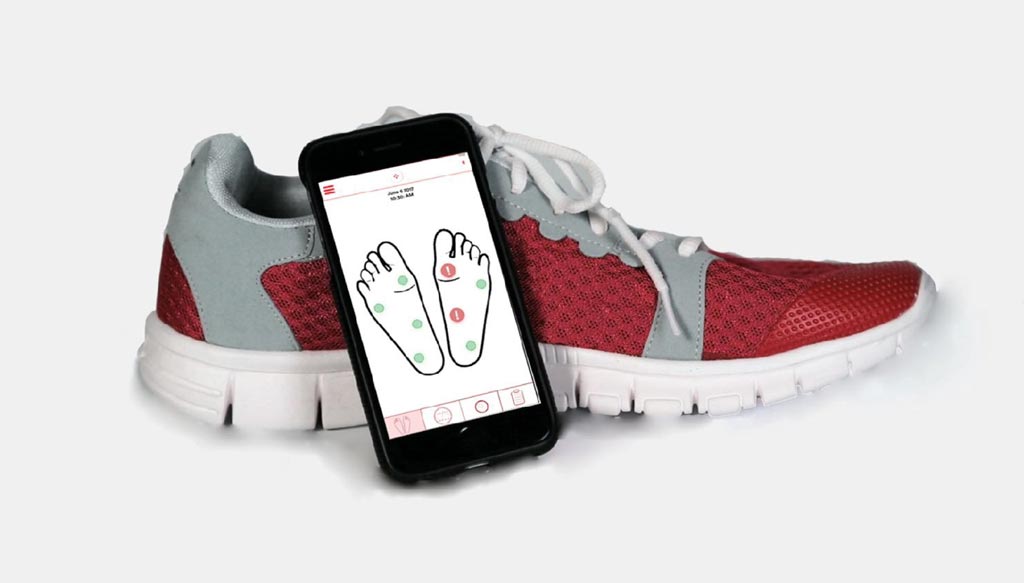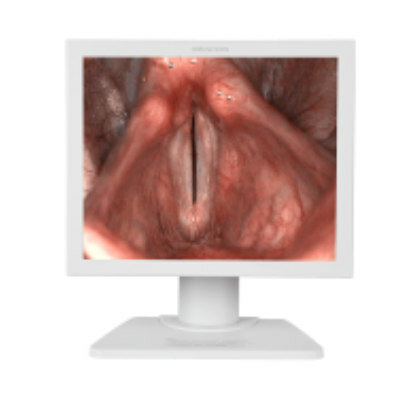Electronic Shoe Insole Monitors Diabetic Foot Health
|
By HospiMedica International staff writers Posted on 14 Oct 2019 |

Image: A graphene insole and smartphone can prevent DFU’s (Photo courtesy of Bonbouton).
A graphene-based insole embedded with a multitude of sensors measures and detects inflammation that could lead to debilitating diabetic foot ulcers (DFUs).
The Bonbouton (New York, NY, USA) Smart Insole, developed in conjunction with the Stevens Institute of Technology (Hoboken, NJ, USA), is designed for insertion into a sneaker or dress shoe to passively monitor feet health in people living with diabetes. The proprietary sensors are made of graphene, an extremely thin sheet of pure carbon with a high flexibility, extreme strength, and electrical and thermal conductivity. The monitoring data are sent to a companion smartphone app, which sends out automatic alerts if an ulcer is starting to form.
The data can also be accessed by the patient and shared with family members, a healthcare provider, or others in order to determine if a surgical intervention or other treatment is needed. Features include compatibility with most footwear styles; four different sizes that can also be trimmed to achieve perfect fit, maximum comfort and effectiveness; easy installation; up to four months of continuous temperature and pressure foot monitoring with the included batteries; and a companion app that is free, easy to set up, and simple to use.
“Bonbouton's smart insoles sense the skin's temperature, pressure, and other foot health-related data, which can alert a patient and his or her healthcare provider when an infection is about to take hold,” said Linh Le, PhD, founder and CEO of Bonbouton. “This simplifies patient self-monitoring and reduces the frequency of doctor visits, which can ultimately lead to a higher quality of life. I am excited to realize the full potential of Bonbouton, taking a technology that I developed as a graduate student at Stevens and growing it into a product that will bring seamless preventative care to patients and save billions of dollars in healthcare costs.”
Graphene is a monolayer atomic-scale honeycomb lattice of carbon atoms which combines the greatest mechanical strength ever measured in any material (natural or artificial) with very lightweight and high elasticity. Graphene has unique optical and thermal properties which allow it to release energy in the form of heat in response to light input; it also has very high electrical conductivity. The high surface area allows bioconjugation with common biomolecules. Andre Geim and Kostya Novoselov of the University of Manchester (United Kingdom) were awarded the Nobel Prize in Physics in 2010 for its development.
Related Links:
Bonbouton
Stevens Institute of Technology
The Bonbouton (New York, NY, USA) Smart Insole, developed in conjunction with the Stevens Institute of Technology (Hoboken, NJ, USA), is designed for insertion into a sneaker or dress shoe to passively monitor feet health in people living with diabetes. The proprietary sensors are made of graphene, an extremely thin sheet of pure carbon with a high flexibility, extreme strength, and electrical and thermal conductivity. The monitoring data are sent to a companion smartphone app, which sends out automatic alerts if an ulcer is starting to form.
The data can also be accessed by the patient and shared with family members, a healthcare provider, or others in order to determine if a surgical intervention or other treatment is needed. Features include compatibility with most footwear styles; four different sizes that can also be trimmed to achieve perfect fit, maximum comfort and effectiveness; easy installation; up to four months of continuous temperature and pressure foot monitoring with the included batteries; and a companion app that is free, easy to set up, and simple to use.
“Bonbouton's smart insoles sense the skin's temperature, pressure, and other foot health-related data, which can alert a patient and his or her healthcare provider when an infection is about to take hold,” said Linh Le, PhD, founder and CEO of Bonbouton. “This simplifies patient self-monitoring and reduces the frequency of doctor visits, which can ultimately lead to a higher quality of life. I am excited to realize the full potential of Bonbouton, taking a technology that I developed as a graduate student at Stevens and growing it into a product that will bring seamless preventative care to patients and save billions of dollars in healthcare costs.”
Graphene is a monolayer atomic-scale honeycomb lattice of carbon atoms which combines the greatest mechanical strength ever measured in any material (natural or artificial) with very lightweight and high elasticity. Graphene has unique optical and thermal properties which allow it to release energy in the form of heat in response to light input; it also has very high electrical conductivity. The high surface area allows bioconjugation with common biomolecules. Andre Geim and Kostya Novoselov of the University of Manchester (United Kingdom) were awarded the Nobel Prize in Physics in 2010 for its development.
Related Links:
Bonbouton
Stevens Institute of Technology
Latest Critical Care News
- 'Universal' Kidney to Match Any Blood Type
- Light-Based Technology to Measure Brain Blood Flow Could Diagnose Stroke and TBI
- AI Heart Attack Risk Assessment Tool Outperforms Existing Methods
- Smartphone Imaging System Enables Early Oral Cancer Detection
- Swallowable Pill-Sized Bioprinter Treats GI Tract Injuries

- Personalized Brain “Pacemakers” Could Help Patients with Hard-To-Treat Epilepsy
- Microscopic DNA Flower Robots to Enable Precision Medicine Delivery
- Origami Robots to Deliver Medicine Less Invasively and More Effectively
- Improved Cough-Detection Technology Aids Health Monitoring
- AI Identifies Children in ER Likely to Develop Sepsis Within 48 Hours
- New Radiofrequency Therapy Slows Glioblastoma Growth
- Battery-Free Wireless Multi-Sensing Platform Revolutionizes Pressure Injury Detection
- Multimodal AI to Revolutionize Cardiovascular Disease Diagnosis and Treatment
- AI System Reveals Hidden Diagnostic Patterns in Electronic Health Records
- Highly Sensitive On-Skin Sensing Monitor Detects Vitamin B6 and Glucose in Sweat
- Artificial Intelligence Revolutionizing Pediatric Anesthesia Management
Channels
Surgical Techniques
view channel
Robotic Assistant Delivers Ultra-Precision Injections with Rapid Setup Times
Age-related macular degeneration (AMD) is a leading cause of blindness worldwide, affecting nearly 200 million people, a figure expected to rise to 280 million by 2040. Current treatment involves doctors... Read more
Minimally Invasive Endoscopic Surgery Improves Severe Stroke Outcomes
Intracerebral hemorrhage, a type of stroke caused by bleeding deep within the brain, remains one of the most challenging neurological emergencies to treat. Accounting for about 15% of all strokes, it carries... Read morePatient Care
view channel
Revolutionary Automatic IV-Line Flushing Device to Enhance Infusion Care
More than 80% of in-hospital patients receive intravenous (IV) therapy. Every dose of IV medicine delivered in a small volume (<250 mL) infusion bag should be followed by subsequent flushing to ensure... Read more
VR Training Tool Combats Contamination of Portable Medical Equipment
Healthcare-associated infections (HAIs) impact one in every 31 patients, cause nearly 100,000 deaths each year, and cost USD 28.4 billion in direct medical expenses. Notably, up to 75% of these infections... Read more
Portable Biosensor Platform to Reduce Hospital-Acquired Infections
Approximately 4 million patients in the European Union acquire healthcare-associated infections (HAIs) or nosocomial infections each year, with around 37,000 deaths directly resulting from these infections,... Read moreFirst-Of-Its-Kind Portable Germicidal Light Technology Disinfects High-Touch Clinical Surfaces in Seconds
Reducing healthcare-acquired infections (HAIs) remains a pressing issue within global healthcare systems. In the United States alone, 1.7 million patients contract HAIs annually, leading to approximately... Read moreHealth IT
view channel
Printable Molecule-Selective Nanoparticles Enable Mass Production of Wearable Biosensors
The future of medicine is likely to focus on the personalization of healthcare—understanding exactly what an individual requires and delivering the appropriate combination of nutrients, metabolites, and... Read moreBusiness
view channel
Philips and Masimo Partner to Advance Patient Monitoring Measurement Technologies
Royal Philips (Amsterdam, Netherlands) and Masimo (Irvine, California, USA) have renewed their multi-year strategic collaboration, combining Philips’ expertise in patient monitoring with Masimo’s noninvasive... Read more
B. Braun Acquires Digital Microsurgery Company True Digital Surgery
The high-end microsurgery market in neurosurgery, spine, and ENT is undergoing a significant transformation. Traditional analog microscopes are giving way to digital exoscopes, which provide improved visualization,... Read more
CMEF 2025 to Promote Holistic and High-Quality Development of Medical and Health Industry
The 92nd China International Medical Equipment Fair (CMEF 2025) Autumn Exhibition is scheduled to be held from September 26 to 29 at the China Import and Export Fair Complex (Canton Fair Complex) in Guangzhou.... Read more













